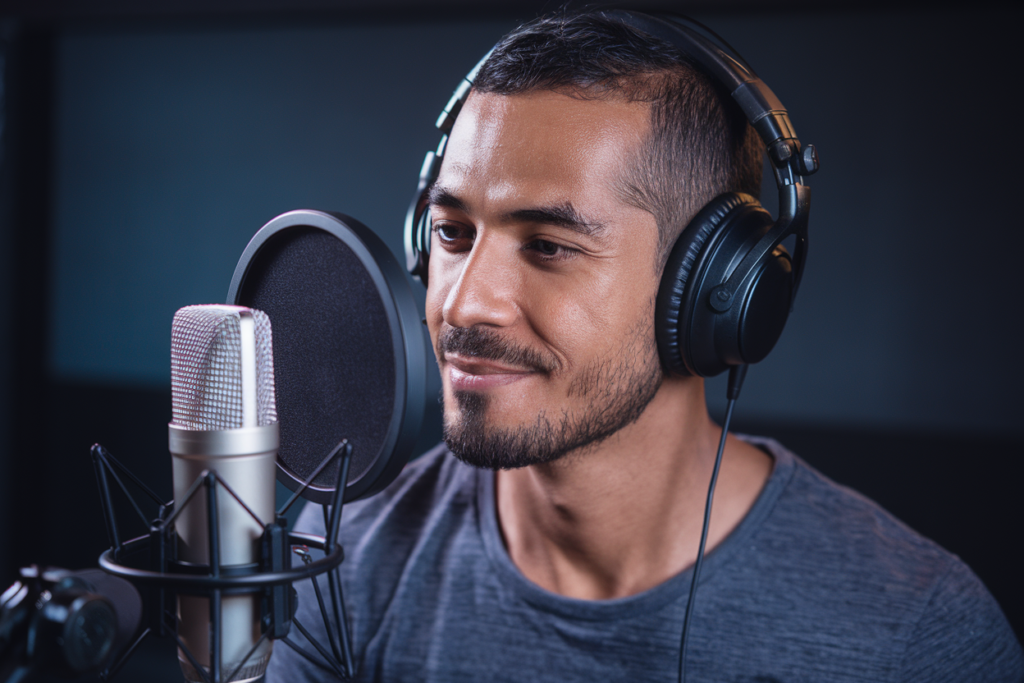Key Takeaways
- Dominance of Egyptian Arabic: Egyptian Arabic is the leading dialect in Arab cinema, largely due to its wide recognition and ability to resonate with diverse audiences.
- Cultural Representation: Films utilizing Egyptian Arabic effectively showcase various aspects of Egyptian culture, making them relatable and engaging for viewers.
- Diverse Dialects Add Depth: Other dialects like Levantine or Gulf Arabic enrich storytelling by providing unique cultural insights, even if they cater to more specific audiences.
- Importance of Voiceovers: Skilled voice actors play a crucial role in bridging gaps between different dialects, enhancing clarity and accessibility while preserving authenticity.
- Challenges in Representation: Misinterpretations and stereotypes can hinder the accurate portrayal of dialects in film, emphasizing the need for cultural sensitivity among filmmakers.
- Evolving Cinematic Landscape: Contemporary films increasingly incorporate a blend of dialects to reflect societal changes and audience preferences, enriching narratives across the board.
Ever wondered why Egyptian Arabic dominates the film industry in the Arab world? It’s not just about history or culture; it’s a fascinating blend of factors that make it the go-to dialect for filmmakers. While other dialects add unique flavors, Egyptian Arabic often steals the spotlight with its widespread understanding and appeal.
Egyptian Arabic vs Other Dialects in Films
Egyptian Arabic stands out as the dominant dialect in Arab cinema, primarily due to its widespread understanding across various regions. This dialect resonates with audiences, making it a go-to choice for filmmakers aiming for broad appeal. You’ll often notice that characters portrayed in films use Egyptian Arabic, as it conveys emotions and narratives effectively.
Other dialects, such as Levantine or Gulf Arabic, bring their own distinct flavors to films but might not have the same level of recognition outside their respective regions. While these variations add richness to storytelling, they often cater to specific audiences. For instance, a film featuring a Levantine accent may resonate deeply with viewers from Lebanon or Syria but could pose challenges for those unfamiliar with the nuances.
Voiceovers play a crucial role when it comes to bridging gaps between different dialects. Skilled voice actors can bring characters to life while ensuring clarity and comprehension across diverse audience demographics. When filmmakers choose voice talent carefully, they enhance the overall viewing experience by ensuring that even regional accents are accessible.
Additionally, incorporating various dialects into films can create authenticity and depth in storytelling. It provides an opportunity for viewers from different backgrounds to connect with characters on multiple levels. Whether it’s through dialogues or voiceovers, each dialect offers unique cultural insights that enrich cinematic experiences.
While Egyptian Arabic dominates Arab cinema due to its accessibility and familiarity, other dialects contribute valuable perspectives that deserve recognition. The interplay of these languages allows filmmakers to craft compelling narratives that resonate widely among diverse audiences.
Historical Context
Egyptian Arabic emerged as a prominent dialect in the early 20th century, largely due to Egypt’s influential role in cinema. Its rise coincided with the establishment of Cairo as the cultural hub of the Arab world. The film industry flourished, giving Egyptian Arabic a platform that reached audiences far beyond its borders.
Origins of Egyptian Arabic
Egyptian Arabic originated from a blend of ancient Egyptian language influences and various waves of migration and conquests throughout history. This fusion created a unique linguistic identity that resonates with many speakers across different regions. The dialect’s distinct phonetics and vocabulary often make it more accessible for viewers unfamiliar with other regional variations.
Evolution of Dialects in Film
As films evolved, so did the use of different dialects, reflecting societal changes and audience preferences. In early cinema, filmmakers predominantly relied on Egyptian Arabic due to its widespread recognition. However, contemporary productions increasingly incorporate diverse dialects like Levantine or Gulf Arabic to enhance authenticity.
The use of voiceovers plays an essential role in bridging gaps between these dialects. Voiceover talent brings characters to life by offering clarity and relatability across varying linguistic backgrounds. By employing skilled voice actors who can switch between dialects seamlessly, filmmakers enrich narratives while appealing to broader audiences.
This evolving landscape showcases how various dialects contribute depth to storytelling while maintaining accessibility through effective voiceover work.
Cultural Influence
Egyptian Arabic plays a crucial role in shaping cinematic narratives, reflecting the rich tapestry of Egyptian culture. Its widespread recognition allows filmmakers to connect with diverse audiences, creating a sense of familiarity and relatability that resonates on multiple levels. The stories told through this dialect often highlight traditions, social dynamics, and historical contexts unique to Egypt, enriching the overall viewing experience.
Representation of Egyptian Culture
Filmmakers use Egyptian Arabic not just for communication but as a vehicle for cultural representation. Iconic films often portray various aspects of life in Egypt—from family values to societal issues—using language that feels authentic and engaging. This authenticity draws viewers in, as they hear familiar phrases and idioms that echo their own experiences. As you watch these films, you might find yourself immersed in the vibrant sounds and rhythms of everyday Egyptian life.
Other Dialects and Their Cultural Context
While Egyptian Arabic dominates mainstream cinema, other dialects bring their own cultural nuances. For instance, Levantine Arabic showcases the distinctive flavors of countries like Lebanon and Syria, highlighting local customs or humor specific to those regions. Gulf Arabic offers insights into the lifestyles prevalent in Saudi Arabia or the UAE while adding depth to character portrayal.
In filmmaking, voiceovers serve an important function when incorporating different dialects. Skilled voice actors can adapt performances seamlessly across linguistic boundaries, ensuring clarity while preserving authenticity. This ability enhances storytelling by making it accessible without losing regional voices’ unique qualities. By bridging gaps between dialects through effective voice talent selection, filmmakers craft more compelling narratives that resonate with wider audiences.
Ultimately, understanding these cultural influences enriches your appreciation for film as a reflection of society’s diversity—a celebration where every dialect adds its own layer to the cinematic experience.
Popular Films Featuring Egyptian Arabic
Egyptian Arabic plays a prominent role in many well-known films, showcasing its cultural relevance and broad appeal. Several iconic films highlight the dialect’s charm and accessibility, connecting with audiences across the Arab world.
Iconic Egyptian Films
Films like The Yacoubian Building (2006) and Omar Sharif in Doctor Zhivago (1965) feature Egyptian Arabic prominently. These movies not only reflect societal issues but also capture the essence of everyday life in Egypt. The dialogue resonates with viewers, making it relatable and engaging due to its familiarity. Additionally, classic comedies such as Ismail Yassine in the Army (1955) showcase humor through Egyptian expressions and phrases, further solidifying this dialect’s impact on cinematic storytelling.
Analysis of Dialect Usage in Current Cinema
Current cinema continues to embrace Egyptian Arabic while incorporating diverse dialects for authenticity. Many contemporary filmmakers blend various regional accents to enhance character development or depict specific settings. This mix adds depth to narratives by reflecting real-life interactions among different communities.
Voiceovers often play a crucial role when integrating multiple dialects within films. Skilled voice actors ensure clarity while maintaining each character’s unique linguistic identity. By using top voice talent adept at navigating these nuances, filmmakers create immersive experiences that resonate deeply with viewers. Characters come alive through authentic voices that match their backgrounds, enriching both narrative complexity and audience engagement.
As you explore these films featuring Egyptian Arabic, consider how language shapes stories and connects cultures—providing insight into shared experiences through a uniquely expressive medium.
Challenges of Representation
Representation in film involves navigating the complexities of dialects. While Egyptian Arabic enjoys popularity, other dialects face challenges that impact their portrayal.
Misinterpretation of Dialects
Misinterpretation often occurs when filmmakers attempt to represent different Arabic dialects. Viewers may struggle to connect with characters speaking a less familiar dialect, leading to confusion and a diminished emotional response. For example, if a voice actor uses a heavy Levantine accent in an Egyptian setting, it can disrupt the authenticity of the narrative. Accurate representation requires skilled voiceovers that respect regional nuances while still appealing to a broader audience.
Stereotypes and Their Impact
Stereotypes significantly affect how various Arabic dialects are perceived in cinema. Often, specific accents become associated with particular character traits or social roles, limiting the complexity of characters from diverse backgrounds. This oversimplification negatively impacts audience perceptions and reinforces biases. When filmmakers incorporate diverse voice talent but fall back on stereotypes, they risk alienating viewers who might feel misrepresented or marginalized.
Navigating these challenges demands attention to detail and cultural sensitivity from filmmakers and voice actors alike. Through thoughtful casting and authentic dialogue delivery, it’s possible to create films that resonate across different audiences while honoring the rich tapestry of Arabic linguistic diversity.
Conclusion
Egyptian Arabic’s prominence in films reflects its unique ability to connect with diverse audiences while showcasing rich cultural narratives. Its historical roots and widespread understanding make it a powerful medium for storytelling that resonates beyond borders.
As filmmakers continue to explore various dialects, the integration of Egyptian Arabic alongside others enriches cinematic experiences and enhances character depth. Recognizing the complexities of each dialect is essential for creating authentic portrayals that honor linguistic diversity.
By embracing these varied voices, you can appreciate how language shapes the film industry and influences societal perceptions across cultures. Each dialect contributes to a vibrant tapestry that captures the essence of everyday life, making cinema a true reflection of our shared human experience.
Frequently Asked Questions
Why is Egyptian Arabic dominant in the Arab film industry?
Egyptian Arabic is dominant due to its widespread understanding across various regions, making it a preferred choice for filmmakers aiming for broad appeal. Its historical emergence alongside Cairo’s rise as a cultural hub also contributed significantly to its prominence.
What are the unique characteristics of Egyptian Arabic?
Egyptian Arabic blends ancient Egyptian influences with elements from migrations and conquests, creating a distinct linguistic identity. This uniqueness resonates with many speakers and makes it relatable in cinematic storytelling.
How has cinema evolved in terms of dialect usage?
While early cinema relied heavily on Egyptian Arabic for recognition, contemporary films increasingly incorporate diverse dialects. This evolution reflects societal changes and audience preferences while enhancing authenticity through character development.
What role do voiceovers play in film dialect representation?
Voiceovers bridge gaps between different dialects, providing clarity and relatability. Skilled voice actors enrich narratives by ensuring each character retains their unique linguistic identity while maintaining overall coherence.
How do films featuring Egyptian Arabic reflect cultural issues?
Films like “The Yacoubian Building” and classic comedies capture everyday life in Egypt, addressing societal issues through relatable dialogue. They highlight the charm of Egyptian Arabic while immersing viewers in authentic cultural narratives.
What challenges do other dialects face in representation?
Other dialects often struggle with misinterpretation and stereotyping, which can limit character complexity and emotional responses. Filmmakers need to approach these representations with cultural sensitivity to honor linguistic diversity effectively.
Why is cultural sensitivity important in filmmaking?
Cultural sensitivity ensures that films resonate authentically with diverse audiences while preserving the richness of different Arab dialects. It helps avoid reinforcing biases or stereotypes that can diminish viewer engagement and emotional connection.







